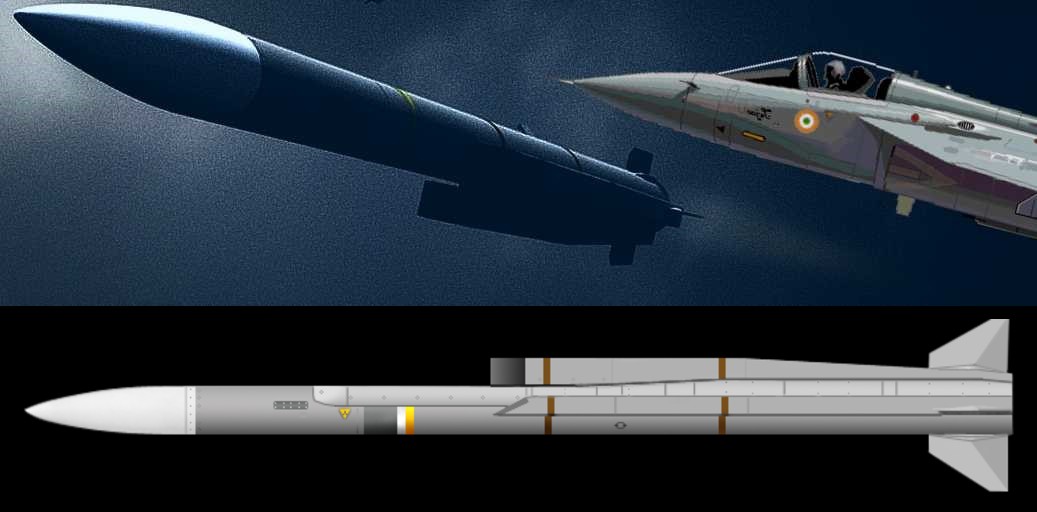In eight months, the Indian Air Force begins receiving its first of 36 Rafale jets, armed with the the world’s longest range air-to-air missile, the Meteor. Highly impressed with the capabilities of the European weapon system, the Indian Air Force had in early 2018 proposed a separate effort to arm some of its other aircraft with the missile. But steadily receding hopes of this possibility over the last year will likely officially die this week when the missile’s maker MBDA meets with the LCA’s maker Hindustan Aeronautics Ltd (HAL) to finally say no, the Meteor can’t be slung into an aircraft if the radar on that aircraft is of Israeli make.
It all started in May 2018, when it was revealed that the Indian Air Force, amidst production troubles with the LCA Tejas, had pushed the ambitious idea of arming the aircraft with the Meteor missile. Seven months later, in December 2018, HAL chose the Israeli Elta EL/M-2052 AESA radar for 83 LCA Tejas Mk.1A jets soon to be ordered by the Indian Air Force.
Livefist learns that MBDA will convey to HAL with finality this week that the LCA Tejas cannot be armed with the Meteor unless the radar on the aircraft is of European make. It will also likely convey that the LCA Tejas has an outside chance of deploying the Meteor — the prospect of future LCA airframes being integrated with the Uttam AESA radar, being developed specifically for the Tejas and AMCA programs. That prospect would be strictly hypothetical, given that the very future of the LCA Tejas program currently hinges on production and capability troubles being ironed out soon.
The situation is an intriguing one. If the Indian Air Force had decided early in 2018 that it wanted the Meteor on the LCA Tejas, then was that not a fait accompli in terms of HAL’s sensor selection? Was the IAF, as some reports suggest, a helpless spectator of decisions that basically grounded a game-changing capability requirement on an aircraft it would be the final operator of? Or, was the Meteor proposal on the LCA weighed against other compulsions, including the necessity for a competitive process? The dilemma suggests, at best, the vagaries of the Indian system pulling operators and integrators in different directions — and at worst, a serious lack of focused planning on a wishlist item that could potentially raise the allure of the LCA Tejas several notches, resulting in more orders.
Livefist can also confirm that HAL has tried to persuade MBDA to consider integrating the Meteor with the Israeli radar as a ‘special case’ for the LCA Tejas and Indian Air Force, though the European firm’s hands are apparently tied on this count. As a sensitive strategic program, integration of the missile beyond a European radar would require intervention from the French government and other agencies. The Meteors on the Rafales in service with the French military, and those headed to the Indian Air Force, are controlled by Thales RBE2 AESA radars, a system that competed and lost out to the Israeli Elta system.
A senior HAL official told Livefist, “The LCA program has come up on Israeli-origin sensors. The EL/M-2052 radar was chosen in a competitive process. The same radar is also now on the new build Jaguar jets. The Indian Air Force has been well aware of the process of selection. At no point has there been any hurdle in the selection.”
A section within the IAF has also argued that the Meteor is a better fit on a platform like the Su-30 MKI (a proposal exists for this too, but could be even more complicated) rather than on a tactical jet like the Tejas.
Another observer of the proceedings, India’s Defence Research & Development Organisation (DRDO) claims to be in the final stretch of proving its Astra beyond visual range air-to-air missile, a weapon system comparable on paper to the capabilities demonstrated by MBDA’s Meteor. The DRDO, on its part, has argued against any roll-out of the Meteor beyond the Rafale fleet in Indian service, assuring the IAF that the Astra is in the pipeline and will meet all performance requirements. MBDA has expressed its willingness to work with DRDO on a variety of programs in the past, and will be keeping discussions going since the Meteor could well be a fit on the future AMCA fifth generation jet.
India’s fifth gen AMCA concept models in stealth & non-stealth configs at #DefExpo18. Our detailed report yesterday: https://t.co/oo9Fnlhxgx pic.twitter.com/f0QLOAbj5q
— Livefist (@livefist) April 12, 2018
Fleetwide weapon commonality is something the Indian Air Force has been actively scouting recently. Livefist reported last week that the IAF will deploy the European ASRAAM on its Russian-origin Su-30 MKI jets this year, with a proposal to see a roll out on other jet types too. However, arming jets with the infrared guided ASRAAM missile, which doesn’t require complex integration with aircraft sensors, is a far simpler exercise than the active guided Meteor that requires source codes and proprietary software tweaks to work. The Meteor, in other words, cannot be effectively integrated without the express involvement of both the radar maker as well as the builder of the missile.
from Livefist http://bit.ly/2RETjSF
via Live Defense

No comments: